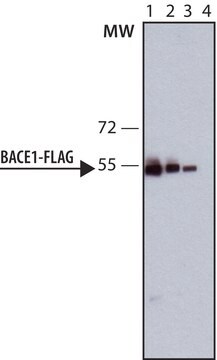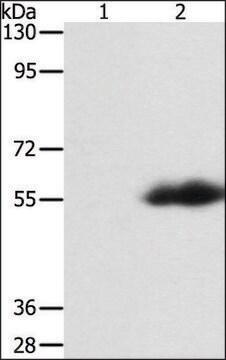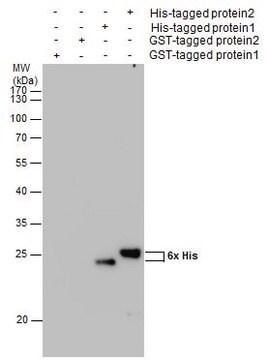H7425
Anti-FLAG®-Peroxidase antibody produced in rabbit
IgG fraction of antiserum
Synonyme(s) :
Anti-FLAG-HRP Polyclonal Conjugate
About This Item
Produits recommandés
Niveau de qualité
Description
buffered aqueous solution
Forme
lyophilized solid
Technique(s)
western blot: 1:2000-1:4000 using for detection of amino-terminal FLAG-BAP fusion protein in an E. coli crude cell lysate
Conditions d'expédition
dry ice
Température de stockage
−20°C
Description générale
ANTI-FLAG recognizes the FLAG epitope located on FLAG fusion proteins. The antibody reacts with N-terminal, N-terminal-Met, and C-terminal FLAG fusion proteins by immunoblotting. Specific staining is inhibited by the FLAG peptide (N-Asp-Tyr-Lys-Asp-AspAsp-Asp-Lys-C). Applications for the conjugate include Western blots and ELISA.
Epitope tags provide a method to localize gene products in a variety of cell types, study the topology of proteins and protein complexes, identify associated proteins, and characterize newly identified, low abundance, or poorly immunogenic proteins when protein specific antibodies are not available. Tagging with the FLAG peptide sequence may be done at the N-terminus, N-terminus preceded by a methionine residue, C-terminus, or at internal positions of the target protein. FLAG may also be placed in association with other tags. The small size of the FLAG tag or sequence and its high hydrophilicity tend to decrease the possibility of interference with the protein expression, proteolytic maturation, antigenicity, and function. The N-terminal FLAG peptide sequence contains a unique enterokinase cleavage site allowing it to be completely removed from the purified fusion proteins. Cleavage catalyzed by Cu2+ ions of the C-terminal FLAG peptide from a fusion protein has been reported. A sequence motif with five out of eight amino acid residues identical to the FLAG peptide is found in both rat and mouse Mg2+ dependent protein β-phosphatase, as well as in the human and bovine enzyme.
Immunogène
Application
Browse additional application references in our FLAG® Literature FLAG® Literature portal.
Forme physique
Informations légales
Clause de non-responsabilité
Mention d'avertissement
Warning
Mentions de danger
Conseils de prudence
Classification des risques
Skin Sens. 1
Code de la classe de stockage
11 - Combustible Solids
Classe de danger pour l'eau (WGK)
WGK 2
Certificats d'analyse (COA)
Recherchez un Certificats d'analyse (COA) en saisissant le numéro de lot du produit. Les numéros de lot figurent sur l'étiquette du produit après les mots "Lot" ou "Batch".
Déjà en possession de ce produit ?
Retrouvez la documentation relative aux produits que vous avez récemment achetés dans la Bibliothèque de documents.
Notre équipe de scientifiques dispose d'une expérience dans tous les secteurs de la recherche, notamment en sciences de la vie, science des matériaux, synthèse chimique, chromatographie, analyse et dans de nombreux autres domaines..
Contacter notre Service technique









